Credits
Feature by: Cullen Gallagher, Victoria Large, Glenn Heath Jr., Lindsay Peters, and Briallen Hopper
Posted on: 05 February 2013
Aldrich, Dassin, Daves, de Toth, Florey, Fuller, Hathaway, Hawks, Huston, Karlson, Kubrick, Lang, Lewis, Lupino, Mann, Ophuls, Preminger, Ray, Siegel, Siodmak, Tourneur, Ulmer, Welles, Wilder, Wise—these are just a handful of the fine filmmakers whose works have come to define the film noir canon. They’ve each their own claim to greatness—but amongst them all, there are three directors who stand apart as artists whose body of work is consumed by noir, who contributed not one, two, or even three noir pictures, but whose cinematic existence is defined by, and gives definition to, noir. Of course, there is Fritz Lang, that titanic German émigré who introduced noir to America, fusing Expressionist aesthetics, pulpy plots, and paranoid psychology. Then there is Robert Siodmak, fellow German émigré and inheritor to Lang’s stylistics who caressed noir’s details with shadowy opulence. And then there is Anthony Mann.
Anthony Mann is America’s hometown noir hero. He navigated uncharted shadows of the American landscape. Not just the back alleys and seedy bars, but national borders, scientific laboratories, sewer systems, taxidermy shops, vaudeville shows. He turned the low-lights still lower, filming his most dramatic scenes in near-darkness, this wisps of light cutting across human faces like a sharp knife. Unlike the romantic domains of so many films noir, filled as they are with freewheeling inebriation, rampant sexuality, exhilarating fisticuffs, one would never want to be trapped in Mann’s world. Heroes don’t save the day, innocent bystanders lose their lives, moral citizens take temptation, criminals backstab each other, and good doesn’t triumph over evil so much as good proves more violent, more vicious, and more relentless, than evil. It’s an unsettling resolution – terror conquering terror – that leaves tension unresolved and terror lingering in the viewer. Mann took the performance out of violence, exchanging beauty for brutality, sadism, and shock. Two shots from the opening of Railroaded best illustrate this: a close-up in which the robber sticks his double-barrel shotgun point-blank in the camera’s face, followed by another close-up of screaming, panic-stricken woman.
Born in California, Mann was raised in New York City. Apprenticed in off-Broadway theater, he returned to Hollywood where he matured in cinema. (For a more detailed biography, look up William Darby’s excellent study of the director, Anthony Mann: The Life and Films.) After making his debut with Dr. Broadway, a cheapie for Paramount in 1942, Mann descended into the depths of Hollywood’s B-Picture kingdom, down the ladder of prestige, first to Universal (for the musical Moonlight in Havana, also 1942), then to Poverty Row’s Republic Pictures for five movies. It is here that Mann honed his generic talent, leaving behind musicals and embracing thrillers. Most notable were 1944’s Strangers in the Night (a gothic mystery about a woman who creates a fictitious daughter to correspond with a marine), 1945’s The Great Flamarion (about a vaudeville marksman duped into committing a murder by a femme fatale), and 1946’s Strange Impersonation (about an acid-scarred scientist getting revenge on her former fiancé and lab partner). In 1945, Mann rose briefly to work at RKO, a two-year association that resulted in three pictures, the most important of which was 1947’s Desperate (about a wrongly accused truck driver and his wife chased by both the police and the real criminals). The title captures an emotion that is increasingly paramount to his characters. Visually, Mann is moving deeper into the umbra and penumbra of the silver screen, becoming more technically comfortable with filming darkness, and more emotionally comfortable with his characters’ darker sides.
Also in 1947, Mann arrived in the Hollywood gutter: Producers Releasing Corporation (PRC), previously home to one of the darkest, dirtiest, cheapest noir pictures of all time, the now-legendary Detour, directed by Edgar Ulmer. In her book, Anthony Mann (Wesleyan University Press), Mann scholar Jeanine Basinger explains then when Mann began working at PRC, the studio had recently merged with J. Arthur Rank, the British distribution company, to form a new studio.
In a move to upgrade the image of PRC, the old name was changed to Eagle-Lion International… The independence of Eagle-Lion afforded Mann the opportunity to keep on making inexpensive films, but to make them under a less studio-dominated atmosphere than he had found at Paramount, Universal, RKO, or even Republic… [F]ormal experiments were actively encouraged. (Basinger 30)
It is here that Mann matures as an artist, visually, dramatically, and thematically. 1947’s Railroaded takes the common noir theme of “the wrong man” accused of a crime he did not commit, however Mann tells it from both the point of the view of the criminals who frame him and the police who attempt to bully and corner him into a conviction through logic and legality. Also made in 1947, T-Men tells the story of undercover treasury agents in pursuit of counterfeiters; it is most significant, however, for inaugurating Mann’s collaboration with cinematographer John Alton. Mann and Alton shared a unified vision of deep black and blinding white, of canted cameras and lacerating shadows, of grotesque close-ups and shocking violence. Theirs is among the most famous and prosperous in film history, and virtually defines the art and style of film noir. Their collaboration continued in 1948 with two pictures: Raw Deal, a double-crossing jailbreak thriller, and He Walked By Night, one of the seminal films in establishing noir’s documentary aesthetic. He Walked By Night follows the police step-by-step as they track a psychopathic cop killer through Los Angeles. Taking over for director Alfred Werker (who ultimately still received credit), Mann continued in the realist noir mode of Jules Dassin’s The Naked City, but divested every last ounce of romance and drama from the genre in exchange for institutional procedure and documentary formalism. One of the film’s co-stars, Jack Webb, was so smitten with the stylistic mélange that he recycled it into his own television series, Dragnet.
As Mann matured, his vision expanded beyond the inner city. 1949 brought about one of Mann’s most audacious, and most exuberant, experiments, Reign of Terror, which brought noir to the French Revolution.
Mann’s career was on the incline. Ascending all his previous way stations, Mann found himself employed at the glossiest of Hollywood studios, MGM. The films there, however, find a beautiful merger of sophistication and grit: Border Incident (about illegal immigration across the Mexican border) and Side Street (about a postman who gives in to temptation and steals a cache of money), both made in 1949.
As Mann’s career continued to evolve, the American-born auteur heeded the call of Manifest Destiny and brought his noir vision to the most American of genres: the western. Devil’s Doorway for MGM in 1950, The Furies for Paramount in 1950, and Winchester ‘73 for Universal-International in 1950. A 19th century thriller about an a assassination on Lincoln set aboard a train, The Tall Target, was made for MGM in 1951. It was the closest Mann would come to the noir thrillers from which his career began. Throughout the 1950s, Mann would stick mainly to Westerns, with the occasional digression into other generic territories. These westerns are amongst the most outstanding and singular in the entire genre, characterized by the same sadism, violence, intensity, and dark lighting motifs as his noir pictures of the 1940s. 1953’s The Naked Spur, 1955’s The Man From Laramie, and 1958’s Man of the West surely belong on any list of the most significant westerns of all time. And just as the 1950s were the decade for westerns, the 1960s were for epics, such as El Cid, The Fall of the Roman Empire, and Spartacus (before he was fired and replaced by Stanley Kubrick). Mann’s final picture saw the director heading in yet another direction, the Cold War espionage film, A Dandy in Aspic. Mann died of a heart attack during filming in 1967; star Laurence Harvey completed filming the production. Would this have set off another decade of inquiry into espionage? Or would, perhaps, it have lead back to the world of thrillers, subterfuge, and criminality from which Mann’s career began?
Anthony Mann’s westerns, the epics, and even the musicals, are deserving of further study. This feature, however, is devoted to those early pictures of Mann’s career, the films noir where his career, style, and vision were born. Over the next week, we will explore some of the highlights of Mann’s noiroutput. In conjunction with this series, we will be presenting Mann’s groundbreaking docu-thriller, He Walked By Night, at 92YnTribeca on January 24th, 2013.
Introduction by Cullen Gallagher
By Cullen Gallagher, Victoria Large, Glenn Heath Jr., Lindsay Peters, and Briallen Hopper ©2013 NotComing.com
Reviews
-
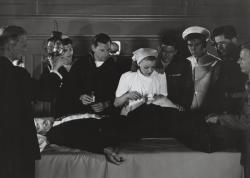
Strangers in the Night
1944 -
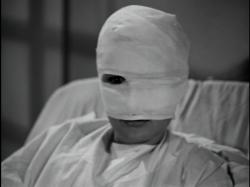
Strange Impersonation
1946 -
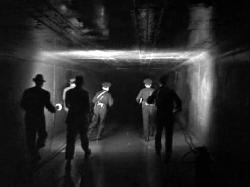
He Walked By Night
1948 -
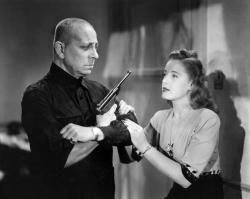
The Great Flamarion
1945 -
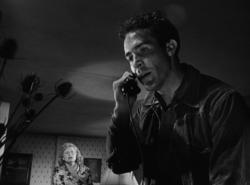
Border Incident
1949 -
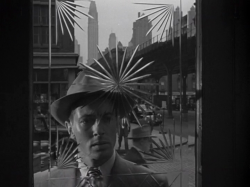
Side Street
1950 -
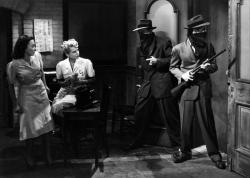
Railroaded
1947
We don’t do comments anymore, but you may contact us here or find us on Twitter or Facebook.



